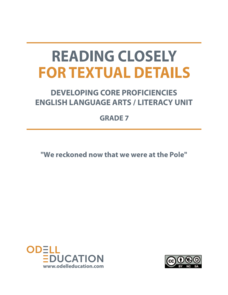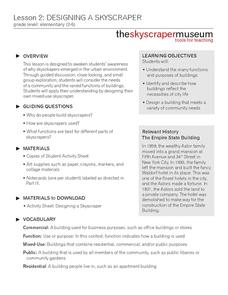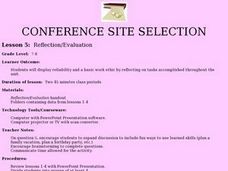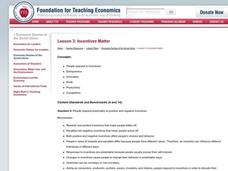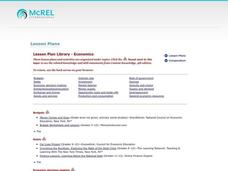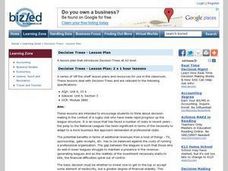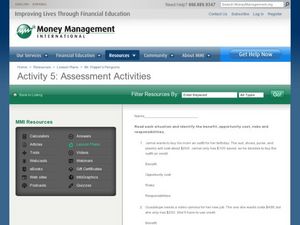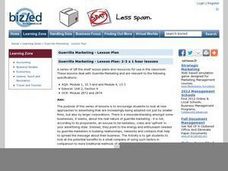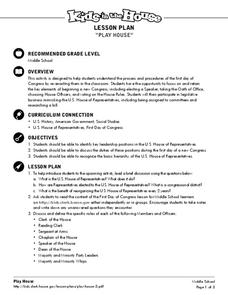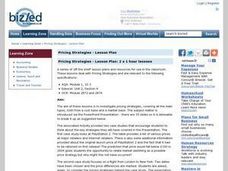Curated OER
Confucianism in a Changing Society
A great lesson plan promotes thoughtful discussion, global perspectives, and links between economics and culture. Learners view four clips showing how Confucian teachings have shaped Chinese culture and how filial piety plays a role in...
Curated OER
From The Great War To The Great Depression
Discover details about 1920's America. In this American history lesson, students read From the Great War to the Great Depression. Students then research famous Americans from the time period and present their findings to their classmates.
Curated OER
Examining What Sharing Really Means
Learners read "The Senegalese Miracle". They discuss the amount of sharing the author finds in Africa. They examine the relationship the author has to the locals.
Odell Education
Reading Closely for Textual Details: Grade 7
Enhance the reading experience with a set of lessons designed to improve textual analysis. Seventh graders use guiding questions to read both informational text and literature closely in the first part of the unit. Next, they work on...
Skyscraper Museum
Designing a Skyscraper
Besides serving as awe-inspiring monuments of human achievement, skyscrapers are built to perform a wide range of functions in urban communities. The second lesson in this series begins by exploring the history of the Empire State...
Curated OER
History: Women Wanting to Work
Students compare and contrast the economic roles of women throughout history in the United States, India, and Israel. After examining pictures of women from various time periods, they share observations. They watch video clips and...
Curated OER
Reflection/Evaluation
Pupils practice the skills of reflection and evaluation. In this reflection lesson, students are grouped together and asked to brainstorm what they have learned during a particular unit. Pupils decide what they want to share with the...
Curated OER
Alaska Trade
Learners spend two days traveling throughout Alaska, trading as they go. They explore universal principles related to trade and commerce while studying about Alaska's geography and indigenous people. At the end of the activity, students...
Curated OER
Break-Even Analysis Worksheet
In this analysis worksheet, students solve accounting problems when provided with variables to be used in computations. Using data provided, students must answer questions showing they understand key terms such as fixed and variable costs.
Curated OER
Incentives Matter
Middle schoolers identify what motive people. They will learn about both positive, and negative incentives. They will use this knowledge to make predictions about how people will behave. They will apply this knowledge to economics.
Curated OER
Micro Economics - Personal Budgeting
High schoolers explore the real world as it relates to money and how people use it. In this money management lesson, students jump into the real world as they role play with money through spending, saving, being married, single, having...
Curated OER
Decision Trees
Students explore the decision-making in the context of a rugby club who have made rapid progress up the league structure. They construct a decision tree using the information given and calculate a final value to make quantitative...
Curated OER
Money situations
In this money situations worksheet, high schoolers read money word problems and then list the benefit, opportunity cost, risks, and responsibilities for each one. Students do this for 6 questions.
Curated OER
Socialism vs Capitalism
Young scholars engage in an activity to show the differences between Socialism and Capitalism. In this socialism and capitalism lesson, students break into groups and are given scenarios to analyze. Young scholars respond to each...
Curated OER
Spending Money
Fourth graders become familiar with the ways people exchange goods and services. In this spending money lesson, 4th graders listen to a chapter from Henry and Beezus and record Henry's earnings and money spent. Students use correct...
Curated OER
What Can You Do With Money?
Students watch a Biz Kidz video about money, learn what they can do with money, and fill out worksheets on what they learn. Students learn about spending, saving, donating, and investing.
Curated OER
Lesson 7 How Do You Pick Winners?
Young scholars see how to identify companies that likely have high growth potential in the fast-growing industries. They gain experience in finding companies that will be winners for the Global Stock Game
Curated OER
Market Research
Students examine the difference between primary and secondary market research. They discover the limitations on marketing strategies. They explain the importance of having more research done before marketing decisions are made.
Curated OER
Systematics: Classifying Organisms
Students describe the techniques biologists use to classify organisms. In this biology lesson, students create cladograms and phylogenetic trees. They list the levels of taxonomic hierarchy.
Curated OER
From Genes to Memes
Students explore changes in evolution. In this evolution lesson, students define genes and memes. Students read an article to recognize the difference between genes and memes. Students explain what a meme is and what factors affect...
Curated OER
Play House
Students take a closer look at representative government. For this House of Representatives lesson, students discuss their local representative in Congress and research his or her responsibilities. Students then participate in a House of...
Curated OER
Service Projects in the Dominican Republic
High schoolers read primary source documents and identify several kinds of service projects conducted by Peace Corps Volunteers; young scholars identify criteria used by the Peace Corps for conducting service projects for the common good.
Curated OER
We've Got the Power
Students examine how power can be generated and the advantages and disadvantages of each method. In this investigative lesson students divide into groups, research the Internet and present it to the class.
Curated OER
Pricing Strategies
High schoolers examine the principles companies use to price their problems. They discover the difference between cost based and market based pricing. They identify other factors that go into pricing decisions.



